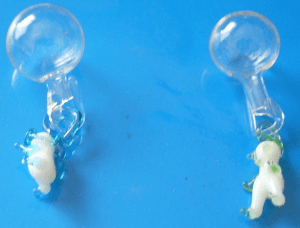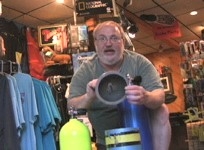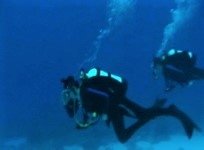Here are video instructions for Cartesian divers. Part 1, Part 2.
What you need:
- Small paper clips. The vinyl-covered multi-colored ones from discount stores work best).
- Small rubber bands. The really small ones for making pony tails are best.
- A clear two-liter soda bottle with lid.
- Either clear plastic straws (a little easier to work with and a little cheaper) or 5/16" outside diameter clear vinyl tubing. The tubing is available off rolls by the foot from any hardware store. The straws are used in many school cafeterias. I've never met a cafeteria lady who wouldn't share some for a good cause.
- OPTIONAL: A tall cup of water for testing for the right density is convenient, as is coat hanger or other wire with a hook to fish out the diver if it stays sunk. See the bottom of this page for a way to make the pull-outer out of straws and paper clips.
Assembly
Step 1: Fold straw or tubing in half and fasten.
Straws: The straws are almost 6" long. Pinching it in the middle makes it easier to bend. Wrap a rubber band several times around the ends to hold them together. Make sure the rubber band is at the end.

Tubing: Cut a 6" piece. Fold it in half, making a hard crease. After folding it as much as I can with my hands, I bite it to really make the fold. Otherwise it's too much of a loop to fit into the bottle. Make sure the rubber band is at the end.

Step 2: Add weight to the diver.

Pull the outside end of a paper clip out a bit.
Hook the Paper Clip This Way
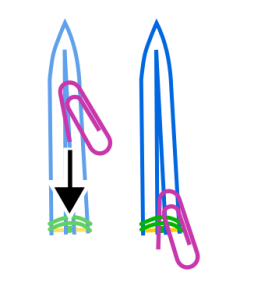
Not This Way
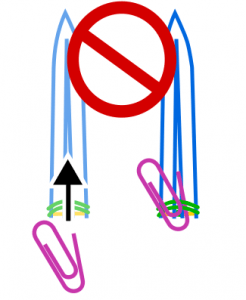
Hook the part you bent out onto the rubber band holding the straw or tube together. It is easiest if you hook it to the part of the rubber band in between the straws. The crossed out way on the right is not so good because the paper clip can fall off easily.
It is hard to say how many paper clips you will need. The idea is to get the diver to be almost all the way submerged, but not quite. The tall cup of water comes in handy here. Occasionally, the sharp bending of the straw will have caused an invisible crack. This will allow air to leak out and the diver will sink no matter what. It happens to one or two percent of the kids in groups I work with. We simply make it part of the lesson and use another straw.
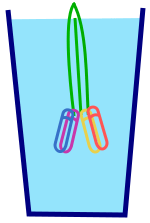
Step 3: Fill the bottle with water and test the diver.
Fill the bottle all the way to the top. It is best to avoid extremes in water temperature. Put the diver in. You might have to use your free hand to help get the paper clips past the bottle neck.
Twist the cap on. I once provided some unintentional comic relief when I forgot this during a demonstration. When I squeezed the bottle, the resultant splash caught me right in the face! Ideally, the diver will sink when you squeeze and rise when you let go. Often, however, the diver benefits from some fine tuning. And if the bottle gets droped on the floor, the diver will stay sunk. See below for instructions to get it working.

If the Diver Does Not Dive: Try squeezing the bottle harder. If that doesn't do it, add more paper clips. You can break a paper clip in half (with scissors and/or bending) and really fine tune the weight.
If the Diver Sinks But Does Not Rise: Did the bottle drop? If so, see the following paragraph. Try removing one paper clip, or replace it with half a paper clip. As noted above, in rare cases a straw could be cracked and leaking air. Replace.
When the bottle is dropped, it invariably stays sunk. The pressure shock has allowed too much water to get into the diver. You must remove the diver from the bottle and shake out the water. Then it will work again. See step 4 for an easy hook for fishing out divers.
If you are using the clear tube instead of the straw, it might get stuck where the bottle narrows at the top. Usually, just shaking the top of the bottle a little solves this problem. If it continues to be a problem, you could add a second tightly wrapped rubber band so the diver is too narrow to get caught anymore.
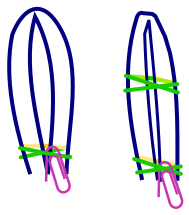
Step 4: Make a Hook Out of Straws, Paper Clips and Tape
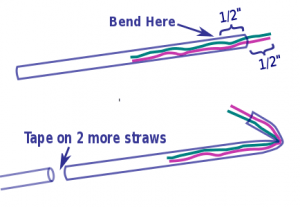
-
- Straighten out two paper clips.
- Place them mostly inside a straw, with just 1/2" sticking out.
- Now bend the straw and the wire inside the straw, 1/2" from the edge.
- You have to tape two more straws onto the first to reach to the bottom.
Because the water bends the light waves (refraction) it is a bit of a challenge to see exactly where the diver is to hook it. Happy fishing!
OBSERVE
Notice that when you squeeze the bottle, the air bubble trapped in the diver compresses and the water level goes up. To explore the Cartesian diver some more, click here.
I'd like to know how this project goes for you. I'm happy to answer questions about it. Feedback from you is an important way for me to know what works and what needs clarification.

